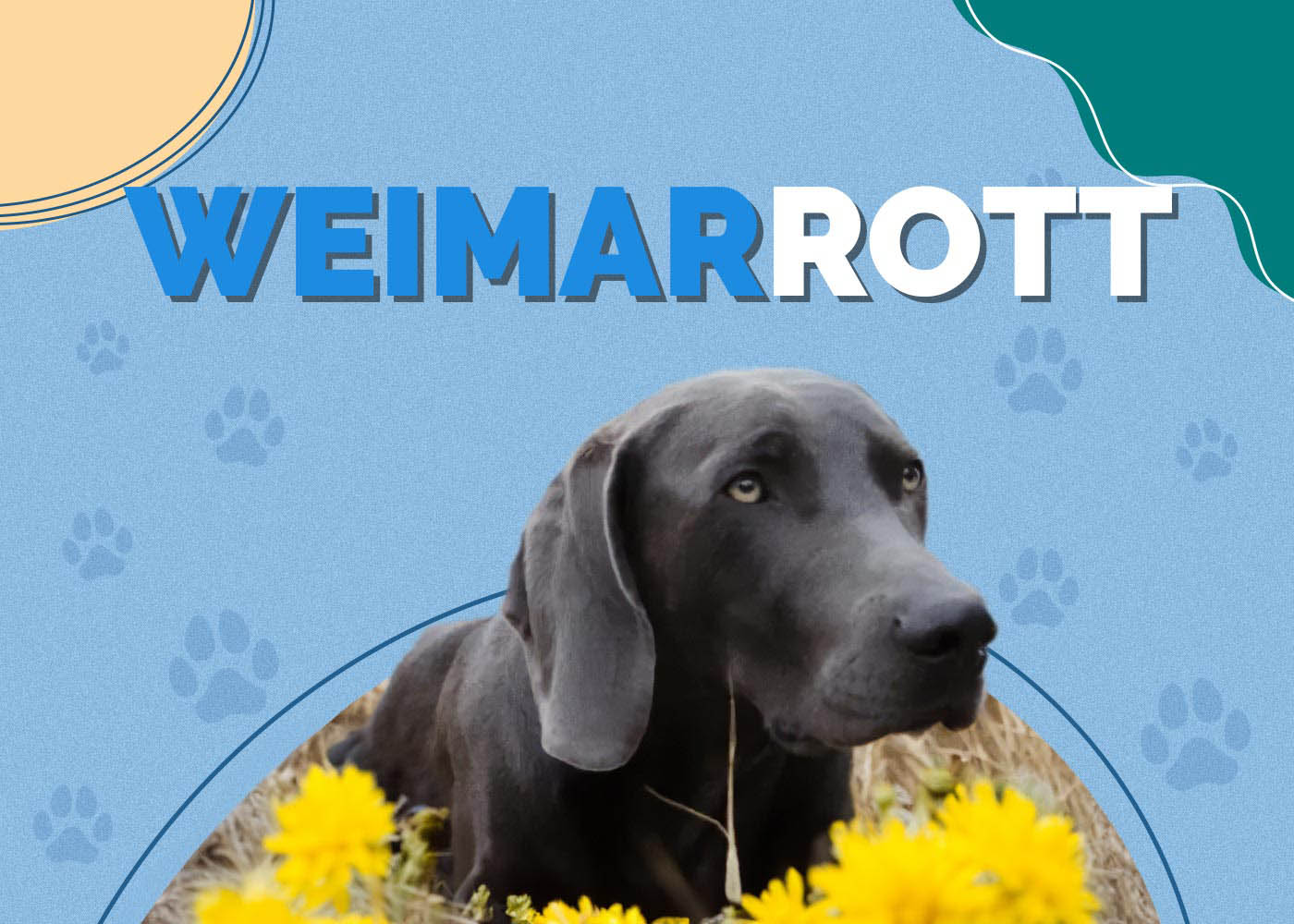Weimaraner Rottweiler Mix (Weimarrott): Info, Pictures, Characteristics & Facts

Updated on

Height:
22-27 inches
Weight:
50-130 pounds
Lifespan:
10-12 years
Colors:
Black, silver, grey, brown, and tan markings may be present
Suitable for:
Active families with children, those looking for a companion, experienced dog owners
Temperament:
Extremely loyal and loving, intelligent, easy to train, friendly, gets along with other pets if socialized early
If you’re looking for a beautiful, active pup, you might want to consider a Weimaraner and Rottweiler hybrid, also called the Weimarrott. They’re gorgeous pups that do great as an active companion—keeping you company both on the move and snuggled up on the couch.
However, if you’re seriously considering this breed, you’ll need to take special precautions. They have their own unique set of issues to overcome. If you can meet their needs, you’ll find one of the most lovable and beautiful dogs you’ve ever owned.
Weimaraner Rottweiler Mix Puppies
Before you run out and pick up a Weimarrott, there are some real concerns you need to examine.
First, these are high-energy dogs. They’ll require plenty of room to run and exercise. Those living in small apartments or those without the ability to give them their required exercise should consider a different breed.
Second, these dogs don’t do too well with smaller pets. They have massively high prey drives and may attack cats or rodents (such as rabbits and hamsters) without warning.
And lastly, this hybrid breed is prone to lots of different medical conditions. They’ll need regular trips to the vet just to ensure their good health. This can quickly rack up expensive veterinary bills.
3 Little-Known Facts About the Weimaraner Rottweiler Mix
1. Weimaraners Are Known as the Grey Ghosts of the Dog World
Weimaraners are called Grey Ghosts due to their hauntingly beautiful grey coats. And this attribute is strikingly clear in the Weimaraner and Rottweiler hybrid. They may have black and tan markings like the Rottweiler; however, they’ll be faded and grey-washed like the Weimaraner.
2. Weimarrotts Can be Extremely Needy and Cuddly
Given the opportunity, you’ll find that your Weimarrott will turn into a giant lap dog. They are extremely loving and loyal to their families.
3. This Hybrid Absolutely Loves Interactive Games and Toys
Weimarrotts are a very intelligent and playful breed requiring mental stimulation along with physical interaction. This can be best achieved through interactive puzzle toys that help to keep them mentally and physically engaged.

Temperament & Intelligence of Weimarrotts 🧠
In general, the Weimarrott is an extremely friendly and loving pooch to members of their families. However, you’ll notice they are slightly aloof towards newcomers and strangers. But once they’ve determined they’re not a threat, your pup will be just as loving to them as well.
They’re also extremely intelligent dogs that can be trained to do many different things. However, this intelligence does have a bit of an independent streak so early obedience training is recommended.
Are These Dogs Good for Families? 🏡
These are amazing family dogs! They love children and take on the role of nanny dog without any hesitation. Weimarrotts are extremely patient dogs and can even handle the torture of little grubby human hands that may get out of control. They’re also extremely playful and encourage interactions between themselves and other members of the family.
Does This Breed Get Along with Other Pets? 🐶 😽
When it comes to getting along with other dogs, it’s important to socialize them early and at young ages. Weimarrotts are naturally only moderately friendly with other dogs in the home. They’ll keep civil, but they won’t enjoy it as much. However, if socialized early, you’ll find that your Weim-Rott mix will love having a friend in the household.
Other pets such as cats or rodents may have a more difficult time. Weimarrotts have a very high prey drive (from their Weimaraner side) and may perceive smaller pets as such. You’ll need to be very cautious when introducing a Weimarrott to a home with other species.
Things to Know When Owning a Weimaraner Rottweiler Mix:
Adopting one of these hybrids isn’t as simple as providing for other dogs. These are strong, active pups that require special care and attention—particularly when it comes to their health.
Food & Diet Requirements 🦴
Due to their high energy levels and size, you need to pay special attention to your Weimarrott’s diet. They should receive between 2-3 cups of highly nutritious food each day depending on how big your pup is.
Their food should be a high protein blend to fully sustain their needs. We recommend Blue Buffalo Wilderness Rocky Mountain Recipe. It’s a grain-free, poultry-free blend with a minimum of 30% protein content. Its chief ingredient is real deboned beef, and it’s packed with tons of heart-healthy fruits and veggies.
Exercise 🐕
Weimaraners were originally bred as royal hunting dogs to specifically chase down large game such as boar, bear, and stag. And although they’ve lost some of their noble roots, their energy remains. Likewise, the Rottweiler was designed to pull butcher carts and herd livestock in its native Germany. Needless to say, the Weimarrott hybrid needs more exercise than the average pooch.
Your mixed breed should receive a solid 90 minutes of dedicated activity every single day. Two miles worth of walking each day should satisfy their physical needs. So if you head out for a morning or evening run, consider bringing them along. They’ll love spending time with you while burning off all of their extra energy.
Training 🦮
Weimarrotts are a very intelligent breed and can be trained relatively easily—once you get through their innate stubbornness, that is. Intelligent dogs tend to have an independent streak about them. However, reward-based training helps to overcome this.
Also, you’ll want to encourage socialization as early as possible. This will prevent any unwanted aggression in later years and make your pup much more fun to be around.
Grooming ✂️
Fortunately, grooming is the easiest part of owning a Weimarrott. They have short coats and shed relatively infrequently. This means you’ll only need to give them a weekly once-over with a slicker brush to keep their coats shiny and healthy.
The biggest area you’ll need to pay attention to is their nail and dental health. They tend to grow longer nails faster—a trait inherited from their Rottweiler side—so be sure to keep a close eye on them and trim when needed. Also, Weimarrotts are more prone to gum and tooth issues. So, regular brushing can keep their smiles beautiful and problem-free.
Health and Conditions ❤️
As beautiful as these dogs are, they’re far from the most robust. They have quite a few health concerns you may have to deal with. Both the Weimaraner and Rottweiler lineages have extensive potential underlying health conditions and the hybrid of the two can inherit any number of them.
The Weimaraner is most at risk for a disease known as Von Willebrand’s disease. This disorder prevents their blood from clotting properly leading to serious injury or death. And while Rottweilers don’t suffer from too many blood or nervous system ailments, their massive size and deep chests promote other issues.
Rottweilers are extremely susceptible to bloat, a condition in which their stomachs rapidly fill with gas and then flip over on themselves. Bloat can be caused by rapid eating and swallowing of air followed by intense play periods. Unfortunately, this breed isn’t known for their slow eating as they wolf down their chow quickly, and they’re also very excitable. You’ll need to be vigilant in watching their mealtime activity.
Weimarrotts are also more prone to structural and bone disorders due to their massive size.
If you do end up owning one of these gorgeous pups, be sure to get them to the vet regularly for testing. Ask your vet to perform the whole gamut of testing including blood and urine, physical examination, eye exams, and DNA for Von Willebrand’s.
- Cherry eye
- Entropion
- Urolithiasis
- Osteochondritis dissecans
- Tricuspid valve dysplasia
- Von Willebrand’s disease
- Osteosarcoma
- Bloat
- Hip and elbow dysplasia
- Lymphoma
- Panosteitis
- Subvalvular aortic stenosis
- Hypothyroidism
- Hemophilia
Male vs Female
When it comes to differences between the sexes in dog breeds, you often find that there is little variation. However, with this hybrid, that isn’t the case.
Males typically grow much larger than the females of the breed. They can stand up to 5 inches taller (at the shoulders) and weigh up to 80 pounds more! This trait is inherited primarily from the Rottweiler lineage as this can be apparent with them as well.
Also, males tend to be more pig-headed and confident. Female Weimarrotts tend to be the more loving and nurturing of the sexes. If you’re considering a Weimarrott for your family with children, you may want to opt for a female.
Final Thoughts
The Weimarrott can be a wonderful addition to any active family’s home. However, you’re going to need to be attuned to their special needs.
They’re strong, high-energy dogs that require ample room to run and an owner capable of challenging them. And due to their mixed heritage, this hybrid has the potential for several health concerns. So, you’ll need to keep them up-to-date with medical checkups and testing.
But if you can keep up with all of these concerns, you’ll find yourself a proud parent of one of the most loyal and loving breeds around.
Featured Image: Pixabay












